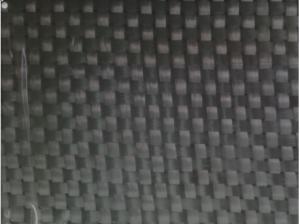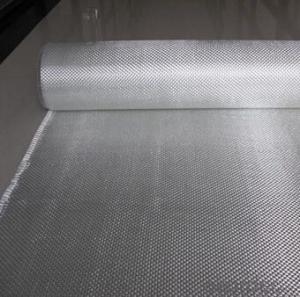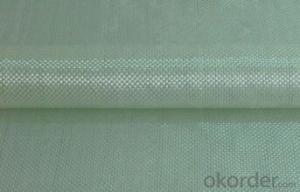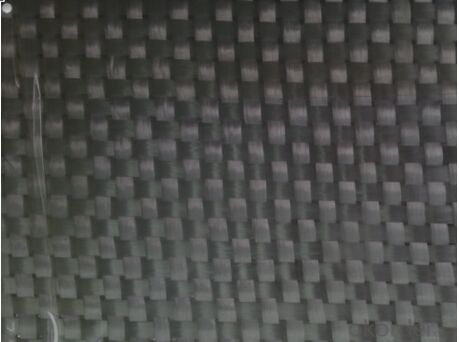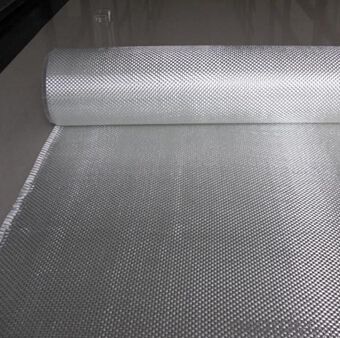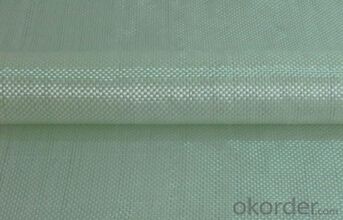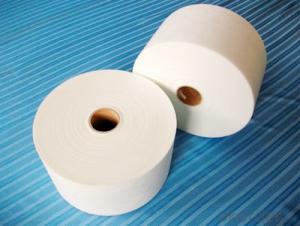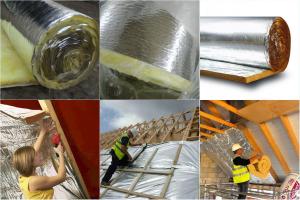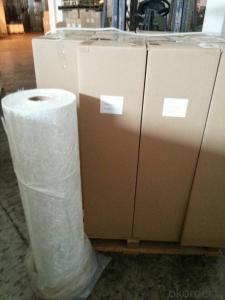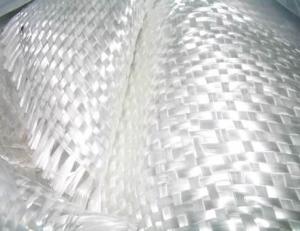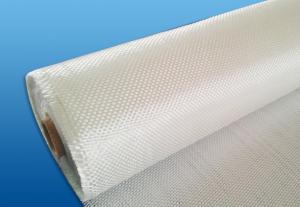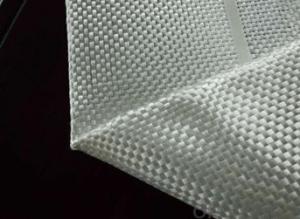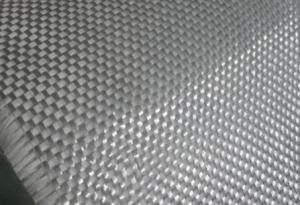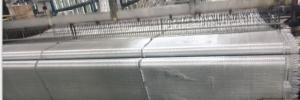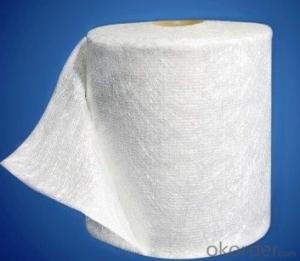Fiberglass Mat Tissue - C-Glass Woven Roving, 800g, 1m
- Loading Port:
- China Main Port
- Payment Terms:
- TT or LC
- Min Order Qty:
- -
- Supply Capability:
- -
OKorder Service Pledge
OKorder Financial Service
You Might Also Like
Structure of Woven Roving
1)Low Fuzz
2)Fast Wet-out&Impregnation
3)Easy Lay-up&Air Release
4)Excellent Mechanical Strength
5)Good Wet Strength Retension
Main Features of Woven Roving
1.CWR400
2.360-380g/m2
3.77.5px or 2250px width
Application of Woven Roving
Unit | Product No. | Weight(gsm) | Technique | Moisture content | combustible matter content(%) |
M | EWR260 | 264±13 | Plain | ≤0.15 | 0.40-0.80 |
M | EWR270 | 261±13.5 | Plain | ≤0.15 | 0.40-0.80 |
M | EWR360 | 354±18 | Plain | ≤0.15 | 0.40-0.80 |
M | EWR500 | 504±25 | Plain | ≤0.15 | 0.40-0.80 |
M | EWR580 | 576±29 | Plain | ≤0.15 | 0.40-0.80 |
M | EWR600 | 622±30 | Plain | ≤0.15 | 0.40-0.80 |
M | EWR800 | 850±40 | Plain | ≤0.15 | 0.40-0.80 |
M | CWR200 | 200±15 | Plain | ≤0.15 | 0.40-0.80 |
M | CWR400 | 385±30 | Plain | ≤0.15 | 0.40-0.80 |
M | CWR600 | 600±45 | Plain | ≤0.15 | 0.40-0.80 |
M | CWR800 | 810±40 | Plain | ≤0.15 | 0.40-0.80 |
Images:

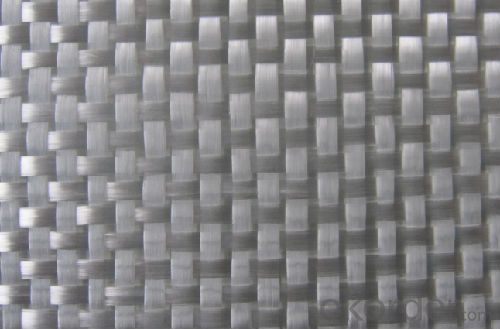
FAQ of Woven Roving
1. Why Choose us?
CNBM is a stated own company, provide the guarantee for the best quality, best service and safety business.
2. How will we guarantee the quality?
a, ISO 9001-2008 quality control system;
b, Strict and regular quality control in production;
c, Inspeciation when loading into container before shippment;
d, Sample stock for one year for quality tracing and record.
3. What is your MOQ?
Our MOQ is one pallet.
4. Can you provide sample?
Yes, samples are in stock. we can offer free sample for you.
5. Payment terms?
We can accept L/C, T/T etc.
6. Do you offer OEM service?
Yes, we can print customers’ logo on the packaging;
And the size and specification can be produced and design according to your demand.
- Q: How is fiberglass mat tissue used in the manufacturing of wind turbine blades?
- Fiberglass mat tissue is extensively used in the manufacturing of wind turbine blades due to its exceptional strength, durability, and lightweight properties. It serves as a critical reinforcement material that enhances the structural integrity and performance of the blades. During the manufacturing process, layers of fiberglass mat tissue are carefully placed and bonded together to form the composite structure of the wind turbine blade. The tissue layers are typically impregnated with a resin, such as epoxy or polyester, to create a strong and rigid matrix. The use of fiberglass mat tissue allows for the creation of complex blade shapes with high dimensional accuracy. It provides excellent resistance against various environmental factors, such as UV radiation, moisture, and temperature fluctuations, ensuring the longevity of the turbine blades in harsh weather conditions. The mat tissue also plays a crucial role in distributing and absorbing the loads experienced by the wind turbine blades. It enhances the overall strength and stiffness of the structure, allowing the blades to withstand the aerodynamic forces exerted by the wind. This reinforcement is particularly important to prevent blade deformation and fatigue, ensuring optimal performance and safety over the lifetime of the turbine. Moreover, the lightweight nature of fiberglass mat tissue contributes to the efficiency of wind turbine blades. The reduced weight of the composite structure enables the blades to rotate more easily and capture more energy from the wind. This, in turn, increases the power output and efficiency of the wind turbine system. Overall, fiberglass mat tissue is a fundamental component in the manufacturing of wind turbine blades, providing essential reinforcement, durability, and lightweight properties. Its use significantly contributes to the performance, reliability, and sustainability of wind energy generation.
- Q: Is fiberglass mat tissue suitable for insulation in wastewater treatment plants?
- Yes, fiberglass mat tissue is suitable for insulation in wastewater treatment plants. It is a commonly used material for insulation due to its excellent thermal resistance, resistance to moisture and chemicals, and its ability to withstand high temperatures. Additionally, fiberglass mat tissue is lightweight and easy to install, making it an efficient choice for insulation in wastewater treatment plants.
- Q: How does the density of fiberglass mat tissue affect its performance?
- The density of fiberglass mat tissue directly affects its performance. Higher density fiberglass mat tissue tends to have better strength, durability, and heat resistance. It also offers improved sound insulation and fire retardant properties. On the other hand, lower density fiberglass mat tissue may provide better flexibility and conformability, making it suitable for certain applications. Overall, the density of fiberglass mat tissue plays a crucial role in determining its specific performance characteristics and suitability for different uses.
- Q: Can fiberglass mat tissue be used for HVAC insulation?
- Generally, fiberglass mat tissue is not utilized for HVAC insulation. The insulation used in HVAC systems typically necessitates materials that are purposely engineered to possess significant thermal resistance and inhibit the transmission of heat or cold air. Fiberglass mat tissue is frequently employed as a reinforcing material in the construction of composite materials, such as fiberglass panels or structures, rather than for insulation purposes. Insulation materials intended for HVAC systems are commonly composed of materials such as fiberglass insulation boards, foam insulation, or mineral wool, which possess superior thermal resistance properties and are specifically tailored for HVAC applications.
- Q: Can fiberglass mat tissue be used for architectural applications?
- Yes, fiberglass mat tissue can be used for architectural applications. It is commonly used as a reinforcing material in architectural elements such as roofing, insulation, and wall panels. Its high strength, durability, and fire resistance make it suitable for various architectural purposes.
- Q: Is fiberglass mat tissue compatible with vacuum infusion processes?
- Indeed, compatibility exists between vacuum infusion processes and fiberglass mat tissue. Frequently, fiberglass mat tissue finds application as a reinforcement material in composite manufacturing procedures, which encompass vacuum infusion. The vacuum infusion process encompasses the utilization of a vacuum to eliminate air and guarantee thorough impregnation of the fiberglass mat tissue with resin. The porous quality of the fiberglass mat tissue permits resin to pass through and thoroughly saturate the fibers, leading to the creation of a sturdy and long-lasting composite component. Consequently, fiberglass mat tissue emerges as an optimal selection for vacuum infusion processes.
- Q: How does fiberglass mat tissue perform in terms of thermal resistance?
- Fiberglass mat tissue displays outstanding performance in terms of thermal resistance. Thanks to the inherent characteristics of fiberglass, such as its low thermal conductivity and high melting point, the mat tissue functions effectively as a shield against the transfer of heat. It efficiently hinders the conduction of heat, restricting the flow of thermal energy through the material. Consequently, fiberglass mat tissue proves to be a superb option for insulation applications that require significant thermal resistance, such as in the construction of buildings, industrial machinery, and automotive parts. Furthermore, fiberglass mat tissue is renowned for its fire-resistant properties, which further enhances its capability to endure high temperatures and provide exceptional thermal insulation.
- Q: What is the chemical resistance of fiberglass mat tissue?
- Fiberglass mat tissue exhibits excellent chemical resistance due to the inherent properties of the fiberglass material. The mat tissue is typically composed of glass fibers that are woven or bound together, providing a barrier against a wide range of chemicals. The glass fibers themselves are highly resistant to corrosion, making fiberglass mat tissue suitable for use in environments where exposure to chemicals is a concern. The chemical resistance of fiberglass mat tissue can vary depending on the specific resin or binder used in the manufacturing process. Different types of resins may provide enhanced resistance to certain chemicals, while others may be more susceptible to degradation. It is important to consider the specific chemicals that will come into contact with the fiberglass mat tissue and select a resin or binder that is compatible with those substances. In general, fiberglass mat tissue is known for its resistance to acids, alkalis, solvents, and many other chemicals commonly found in industrial and commercial settings. It can withstand exposure to a wide range of corrosive substances, making it a versatile and durable material for various applications. However, it is worth noting that prolonged exposure to highly concentrated or aggressive chemicals may eventually cause some degradation or deterioration of the fiberglass mat tissue. Therefore, it is essential to consult the manufacturer's specifications and guidelines to ensure proper chemical compatibility and performance in specific environments.
- Q: What are the potential health hazards associated with working with fiberglass mat tissue?
- Working with fiberglass mat tissue can pose several potential health hazards due to the nature of the material. One primary concern is the inhalation of fiberglass particles, which can cause respiratory issues. When fiberglass is cut or handled, it releases small particles into the air that can be easily inhaled. Prolonged exposure to these particles may lead to throat and lung irritation, coughing, and difficulty breathing. Another potential health hazard associated with fiberglass mat tissue is skin irritation. The tiny fibers from the material can irritate the skin upon contact, causing redness, itching, and rashes. In some cases, prolonged exposure or repeated contact with fiberglass can result in more severe skin conditions such as dermatitis. Furthermore, fiberglass mat tissue can also cause eye irritation and damage. If fibers come into contact with the eyes, they can cause redness, itching, watering, and even corneal abrasions. It is important to wear appropriate eye protection, such as goggles, to prevent any potential eye injuries while working with fiberglass. To mitigate these potential health hazards, it is crucial to follow safety guidelines and use personal protective equipment (PPE) when working with fiberglass mat tissue. This includes wearing a respirator mask to prevent inhalation of particles, using gloves and protective clothing to minimize skin contact, and wearing safety goggles to protect the eyes. Regular cleaning and good hygiene practices are also essential to minimize any potential health risks associated with fiberglass. It is important to clean work areas properly to remove any loose fibers, and to wash hands and exposed skin thoroughly after working with fiberglass. Overall, while working with fiberglass mat tissue can present potential health hazards, taking appropriate safety precautions and following safety guidelines can significantly reduce the risk of any adverse health effects.
- Q: How does the fiber content of fiberglass mat tissue affect its strength?
- The fiber content of fiberglass mat tissue directly affects its strength. A higher fiber content typically results in a stronger fiberglass mat tissue. The fibers provide reinforcement and structural integrity to the tissue, making it more resistant to breaking or tearing. Additionally, a higher fiber content enhances the overall durability and load-bearing capacity of the fiberglass mat tissue.
Send your message to us
Fiberglass Mat Tissue - C-Glass Woven Roving, 800g, 1m
- Loading Port:
- China Main Port
- Payment Terms:
- TT or LC
- Min Order Qty:
- -
- Supply Capability:
- -
OKorder Service Pledge
OKorder Financial Service
Similar products
Hot products
Hot Searches
Related keywords
